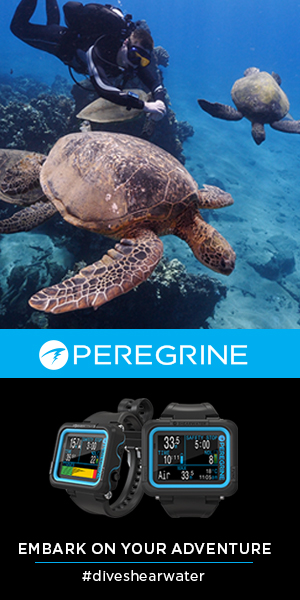THE GIANT STRIDE ENTRY (GSE) is one of the most common types of water entries you will encounter in the world of diving. This skill is performed from various types of decks, including docks, charter dive boats or other kinds of stable platforms. Giant strides can be executed on any type of deck ranging from about three to six feet (1 to 2m) above the water. When done correctly this skill requires minimal effort or time to accomplish, (Photo 1).
Tips For Success
First of all, when just starting out as a diver, it helps to practice the GSE at a pool using only snorkeling gear before trying it with a full set of scuba gear.
Always evaluate the entry area before gearing up. This is especially important if diving from a boat. Check for any visible hazards. Entry areas vary from boat to boat. Some are as much as six feet (2 m) above the surface of the water making it necessary to perform a high-platform version of the GSE. You may need assistance from a crewmember, especially if there are no handrails or bars to grasp for balance (Photo 2). A water-level swim platform extending from the stern of a boat is the easiest type of entry area. If you are diving from a stable platform such as a pool deck or dock, check the water level to confirm it is deep enough for a safe entry. If you don’t know the depth, do not enter the water to avoid an injury.
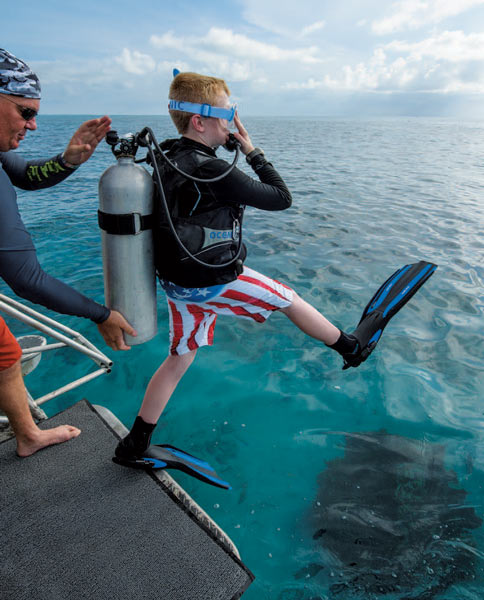
[TWO] If the entry area is high or the boat is rocking, you may need assistance from a crewmember.
Photo by Barry and Ruth Guimbellot.
THE GIANT STRIDE STEP BY STEP
Step One — Approaching the Entry Area
If diving from a boat, you will be given a pre-dive briefing to learn boat procedures and specifics about each dive location. Following the briefing, finish donning your gear and perform a buddy check with your dive partner. Make sure your gear is in place and working properly. Also check the tank to assure the air is turned on. Depending on boat policies and crew instructions, you will either carry or wear your fins to the entry area. When carrying fins, proceed to the entry and don the fins prior to the GSE. If you are asked to wear your fins, slip them on and carefully shuffle heels first or step sideways to the entry point.
After donning the fins, place your mask securely on your face and the regulator in your mouth. Partially inflate your buoyancy compensator (BC). Move to the outer edge of the platform, place the balls of your feet on the outer edge and extend the fin blades over the water. Whether entering the water from a rocking boat platform or a stationary pool deck, position your feet so the fin tips are not below the surface as you begin your giant stride. Once you are properly positioned and ready to make your entry, take one last look into the water close to the entry point to confirm there are no obstructions (such as another diver) in the vicinity (Photo 3). Watch for diver’s bubbles beneath the surface. If you see any bubbles, delay your entry until the area is clear.
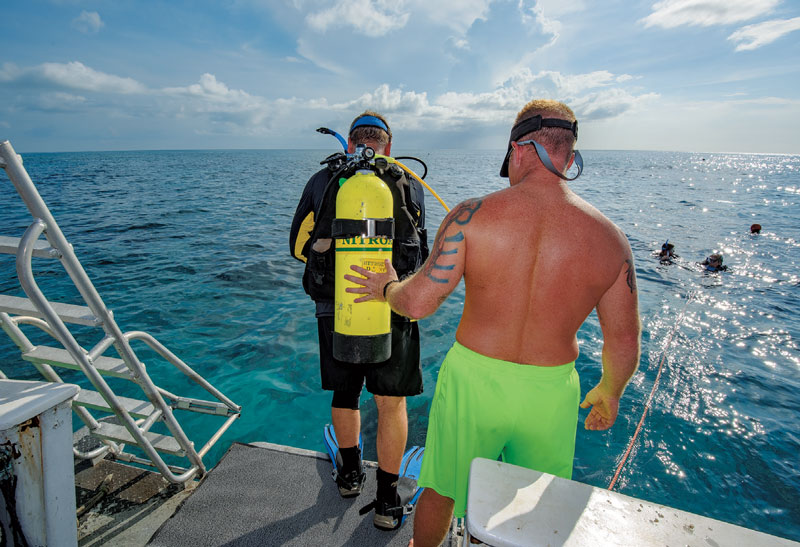
[THREE] Before entering, take one last look at the entry point to confirm it is clear. If other divers are nearby, wait until they move away.
Photo by Barry and Ruth Guimbellot.
Step Two — Securing Your Gear
Once you have ascertained that the entry area is clear, secure your gear by placing the palm of your hand over the second-stage regulator and spread your fingers across the front of the mask. Gently but firmly hold the regulator and mask against your face to prevent them from becoming dislodged on entry. If you are wearing a conventional weight belt, use your free hand to hold the buckle in place. This will prevent the buckle from opening on entry, possibly allowing the loss of the weight belt.
When wearing a weight-integrated BC, use one hand to secure your mask. The other hand can be used to hold gauges close to your body or used to secure the mask strap (Photo 4). The choices you make are determined by your gear configuration and personal preference. Your scuba instructor can help you decide what works best for you.
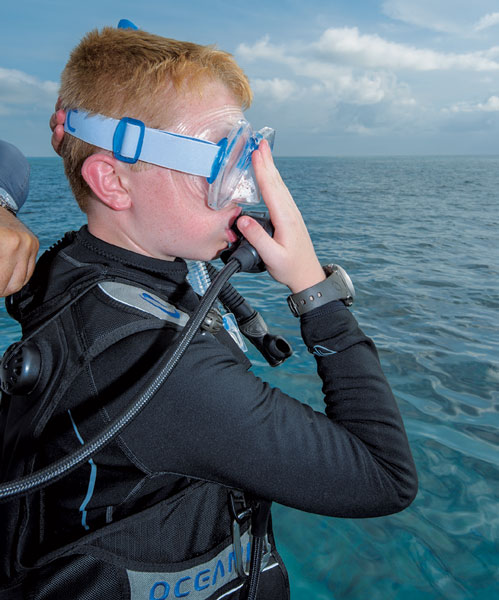
[FOUR] When wearing a weight-integrated BC, use one hand to secure your mask. The other hand can be used to hold gauges close to your body or to secure the mask strap.
Photo by Barry and Ruth Guimbellot.
Step Three — Giant Stride in Action
Now that you have completed Steps 1 and 2, it is time to complete the entry. After a quick look to confirm the area below is clear, place hands in their proper positions, look straight ahead and take a giant step outward from the entry platform. To execute a successful giant stride, it is especially important to look and stride toward the horizon. By doing so, your body will remain vertical, creating the desired entry into the water.
Either leg may be used to stride outward from the platform. Raise the leg high, keeping the fin tip pointing upward to avoid dragging it in the water, which can cause an awkward “face plant” entry. The foot remaining on the platform will pivot on the edge as you are carried away from the boat by the momentum of the giant stride (Photo 5). As you take this giant step away from the boat, enough space will be left for the scuba tank to clear the entry platform.
In rocky seas, proper timing is critical to making a safe GSE. Time the giant stride entry for when the boat pauses at the peak of the platform’s upward movement just prior to the boat’s descent. The split-second timing will prevent you from being thrown off balance by the upward motion of the boat. Instead, you and the boat will both move in a downward motion at the same time.

[FIVE] When making the stride, simply take one forward step, lifting your foot so the fin tip points upward as you enter. Do not leap or jump.
Photo by Barry and Ruth Guimbellot.
Step Four — Ready to Dive
When executing a giant stride correctly, you will enter the water in a vertical position. If striding from a low platform, you can minimize the entry depth by bringing your legs together immediately after contacting the water. This motion will reduce your downward momentum by creating an upward thrust. When making a GSE from a higher platform, this is not appropriate. Instead, immediately after making your giant stride, bring your legs together in a straight line with your torso and make a sleek entry. You will go a little deeper into the water but due to the partial inflation of the BC, you will surface quickly and safely.
After every entry, regardless of where, when or how high, always remember to immediately turn to the boat or shore personnel and give an OK signal by placing your fingertips on the top of your head. If you need assistance, wave your hand(s) back and forth above your head.
Prior to your next dive vacation, take some time to practice the giant stride entry by following the steps in this article. Before you know it, you will be making the giant stride entry in one smooth, continuous motion (Photo 6).
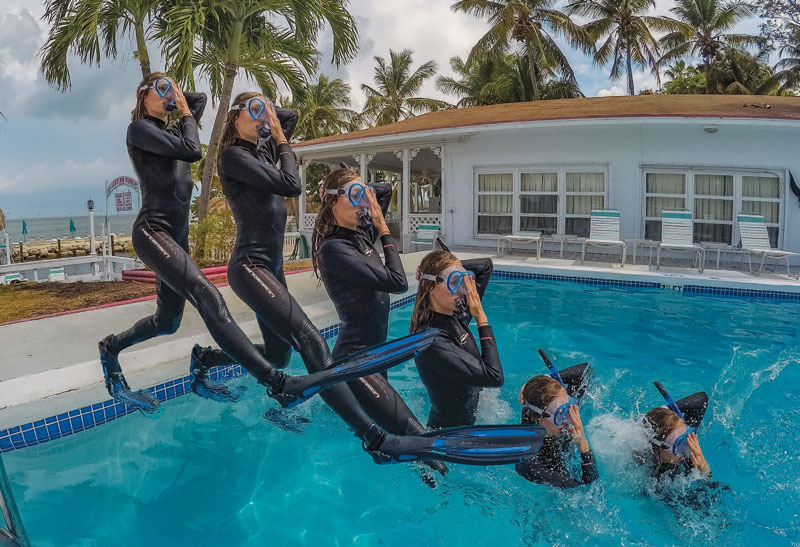
[SIX] Before you know it, you will be making the giant stride entry with ease.
Photo by Barry and Ruth Guimbellot.


